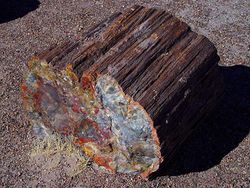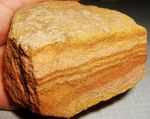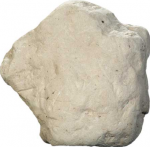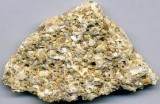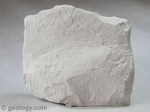Fossils/Earth Materials
- Main article: Fossils
Earth materials make up the final section on the National Fossil List, covering more miscellaneous materials not seen elsewhere on the list. All of these materials are of importance to the study of fossils and early life on earth, and many can contain fossils. Falling into this category are some sedimentary rocks, trace fossils, stromatolites and preserved tree resins (amber and copal).
Trace Fossils
A trace fossil, also known as an ichnofossil is a geological record of biological activity. Ichnology is the study of such traces, and is the work of ichnologists. Trace fossils may consist of impressions made on or in the substrate by an organism: for example, burrows, borings (bioerosion), urolites (erosion caused by evacuation of liquid wastes), footprints and feeding marks, and root cavities. The term in its broadest sense also includes the remains of other organic material produced by an organism — for example coprolites (fossilized droppings) or chemical markers — or sedimentological structures produced by biological means - for example, stromatolites. Trace fossils contrast with body fossils, which are the fossilized remains of parts of organisms' bodies, usually altered by later chemical activity or mineralization.
Stromatolites
Stromatolites ("layered rock" in Greek) are sedimentary rocks formed by layers and layers of cyanobacteria. Cyanobacteria are single-celled microbes can form large sheets called microbial mats, which is one of the earliest recorded forms of life. These microbial mats trap sediment and bind it together, forming stromatolites. Stromatolites typically form in shallow water, as both cyanobacteria and sediment are plentiful in these environments. Stromatolites are primarily made up of limestone, though dolostone may also be a component. They can grow in a variety of structures, typically taking the form of mounds or columns.
Stromatolites are particularly significant because of their documentation of early life on Earth. They are the oldest fossils, going back 3.5 billion years and providing an image of what the environment was like at that time. Cyanobacteria produced oxygen through photosynthesis in a time where oxygen was scarce and even toxic to other organisms. Because cyanobacteria photosynthesized, they released oxygen into their environment and changed the composition of the atmosphere. Before the Great Oxidation Event the atmosphere's oxygen content was only 1% of what it is today. This change paved the way for the Cambrian explosion and the development of multicellular organisms.
Amber and Copal
Amber and copal are natural tree resins, sometimes referred to as organic gems. Tree resin that has been polymerized due to pressure and heat first becomes copal, a softer and younger resin than amber. While the two resins appear very similar, they are very different in terms of age and other properties. Due to the fact that both amber and copal are comprised of tree resin, insects or other small inclusions may also be found inside. Amber due to its age tends to feature inclusions of extinct or other rare species, and is much more valuable as a result. Since copal tends to be much younger than amber, its inclusions may be more modern and common.
Amber and copal are formed by molecular polymerization, hardening the resin released by the tree. This process occurs due to a combination of high pressure and heat from sediment that buries the resin. These two factors eliminate terpenes, organic compounds that give tree resin its characteristic smell and texture. However, since tree resin is organic, the conditions necessary for it to become amber are very similar to those involved in fossilization. A majority of resin simply breaks down instead of becoming amber, which is why amber is so rare. In order to resist this decay, tree resin must not be exposed to elements such as sunlight, rain, or heat.
While it is a common misconception that amber is made out of tree sap, sap and resin are not the same. While they are both liquids released by a tree or other plant, sap and resin are made of different components and serve different purposes. Sap specifically carries nutrients and hormones through the xylem (from roots to the stem and leaves) and the phloem (transporting products of photosynthesis throughout the plant). Resin's purpose is to protect the plant from insects or other predators, as well as serving a purpose similar to blood clotting over a wound. When a tree is injured, it releases resin that then hardens and covers over the damaged area. This prevents further damage from taking place.
Petrified Wood
Petrified wood is a specific type of fossil, produced when wood undergoes a process known as petrifaction or petrification. The pores in the organic material of the tree are filled with minerals, and then water containing minerals dissolves any original organic material left over while replacing it. The result is a three-dimensional stone representation of a preserved tree.
Petrifaction has two steps: permineralization and replacement. There are several different methods for how permineralization can occur, but the most common is silification. Rocks are weathered by water, releasing silica compounds. This water can then permeate the cells of an organism, eventually dehydrating and forming a cast. Since silification is the most common form of permineralization, most petrified wood is made of silicates like quartz or chalcedony. However, small inclusions such as carbon or manganese account for the variety of colors that petrified wood can come in.
In petrified wood, the petrifaction process typically begins when the wood is buried under sediment saturated with water or volcanic ash. Many petrified wood specimens have been found in deltas and floodplains as a result. This creates the perfect environment for fossilization, as there is very little oxygen and as a result bacteria cannot break down the wood. Then, water that contains minerals flows through the sediment or ash, paving the way for permineralization.
There are a variety of petrified forests in North America, including the Petrified Forest National Park in Arizona. The petrified trees in Arizona were thought to have lived during the Late Triassic epoch, as other fossils from that time such as gingkoes and ferns have been found. The fossils found there have allowed paleontologists to paint a detailed picture of what Arizona was like during the Late Triassic.
Sedimentary Rocks
- Main article: Rocks and Minerals#Sedimentary Rocks
Sedimentary rocks are rocks that are made up of grains of sediment or other small particles. They can be classified into four different groups based upon how they are formed - clastic, biochemical or biogenic, chemical, and a separate group for rocks that may be formed in other ways. The rocks important to the National Fossil List are either clastic or biogenic.
Sedimentary rocks are formed when rocks are broken down into small particles known as sediment and deposited into an area with the proper conditions. As more and more sediment builds up over time, it compacts under pressure and releases the liquids trapped in the pores of the young rock. As this liquid is released from the sediment, minerals often precipitate and cement the sediment particles together. Over time, the sediment becomes hard and the grains come together to form a sedimentary rock. This transformation after the sediment is deposited is also known as diagenesis.
Permineralization is one of the most common ways that fossils are preserved in sedimentary rocks. Permineralization is considered a form of diagenesis, and when organisms undergo permineralization they are going through the same process as the rock they are contained in. Organic material can also undergo a reaction leaving behind a thin layer of carbon or graphite. This is known as carbonization, and preserves many plant fossils. Fossils are formed at the same time as the rock is, due to the pressure and other influences in the environment.
Clastic Rocks
Clastic rocks are composed mostly of smaller rock fragments, cemented together by silicates. While not all clastic rocks are sedimentary, all of the rocks on the National Fossil List are. Clastic rocks can be classified by the size and composition of the sediment, though the only classifications relevant to this event are sandstones, mudstones, and siltstones.
Sandstone
Sandstone is a rock consisting of sand-sized grains around 0.0625 to 2 mm in diameter. Sandstone often exhibits very distinct banding or layers, and is typically composed of quartz or feldspar. Calcite and silica bind these particles together to form sandstone. However, inclusions of other materials can result in different color patterns. Iron oxide is one of the most common inclusions, resulting in a deep red or pink color. Sandstone can also be further classified based on its composition and the proportions of its included elements.
Because sandstone is typically made of sand or sand-sized grains, it also typically forms in areas where this sediment is found. In marine environments sandstone is typically created in shallow ocean areas, such as deltas, beaches, and tidal flats. On land, sandstone is commonly formed in rivers, streams, and lakes.
Mudrocks (Mudstone, Siltstone and Shale)
Mudstone and siltstone are both mudrocks, meaning they are composed of incredibly small mud-sized particles. Mudrocks make up more than half of all sedimentary rocks, but are difficult to study in the field due to their particle size. While it can be easy to confuse different types of mudrocks, their differences lie in their composition and particle size. Mudstone contains a mixture of silt- and clay-sized particles, while siltstone is mostly composed of silt-sized particles. This is an important distinction, as it means that mudstone has many particles less than 4 micrometres in size, while siltstone will likely have very few (if any at all). Of course, this distinction is difficult to make with the naked eye and often requires further investigation under a microscope.
Mudstone is typically made of silicate materials with a grain size of up to 0.064 millimeters. Because of the way that mudstone is formed, the clay materials can eventually align into plates and form layers. This creates a trait known as fissility, where a rock tends to split across flat planes. This trait (along with its composition) separates shale from mudstone.
Shale is the most common sedimentary rock, being made up of a mix of clay, mud and other small sediments (typically quartz and calcite). Because shale contains small particles of various minerals, it can also appear in a variety of colors. Common colors of shale are brown, gray, tan, and black. Lagerstätte on the fossils list that are composed mainly of shale include the Burgess Shale and the Mazon Creek fossil beds.
Biogenic Rocks
Biogenic (or biochemical) rocks are typically made up of the remains of small organisms, such as Foraminifera. They are also made up of minerals created by organisms, and other organic remains. The limestones on the fossil list are typically made up of aragonite and calcite, both of which are forms of calcium carbonate.
Coquina
Coquina is a form of limestone made almost entirely of small shells and the remains of invertebrates. The most common fossils found in coquina are that of molluscs and trilobites, but other fossils may be found as well. Coquina has larger particles than rocks like sandstones or mudrocks, with its particles typically being larger than 2 mm in size. Because the shells are typically made up of calcite or phosphate, that is what coquina is composed of.
Coquina is typically formed in marine or lake environments where shells and remains will be sorted and deposited. Then, the shells will undergo diagenesis and become a sedimentary rock. Coquina from as old as the Devonian have been found in deposits all over the world, with many rocks being found in the Americas and Australia.
Fossiliferous Limestone
Fossiliferous limestone is simply any limestone containing fossils. Coquina is a type of fossiliferous limestone, and so is chalk. Because fossiliferous limestone is simply limestone with fossils in it, it is also typically made up of calcium carbonate in the form of aragonite and calcite. Limestone from the Carboniferous Period is particularly common in Great Britain in Ireland, with other deposits from a variety of time periods being found around the world.
The fossils contained within these rocks can be of any size, from microscopic to massive. Many fossils found in these rocks include crinoid stems, as well as other invertebrates such as brachiopods and molluscs. However, over time some fossils (especially diatoms) may convert into other minerals, leaving behind very little evidence of their existence. These rocks are very prevalent in Lagerstätte around the world.
Chalk
Chalk is a white, porous form of limestone formed in marine environments. It is primarily composed of the shells of microscopic organisms called coccolithophores. Chalk can be found in stiff, steep ridges and cliffs as it has high resistance to weathering. Chalk was also one of the earliest rocks to be investigated under a microscope, where its composition was discovered.
While chalk is most commonly known for its uses in schools and in artwork, many modern chalks are not made of mineral chalk. Gypsum-based chalk is very inexpensive to produce and is wide-spread, but other sources of calcium carbonate may be used and marketed as dustless chalk.
Chert
Chert is a hard sedimentary rock composed of many fine pieces of quartz, also known as silica. Chert is typically found as a result of fossilized ooze, found in large amounts on the deep ocean floor. It often contains the remains of diatoms, as well as other small organisms. Similar to shale, if trace elements are left over in the rock it may exhibit different coloration. However, chert is most commonly gray, brown, or red.




